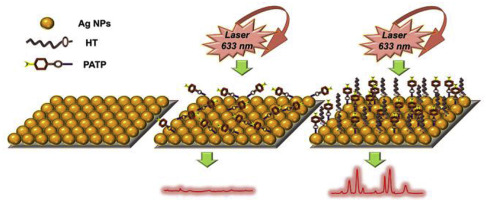当前位置:
X-MOL 学术
›
Anal. Chim. Acta
›
论文详情
Our official English website, www.x-mol.net, welcomes your feedback! (Note: you will need to create a separate account there.)
Controlling the orientation of probe molecules on surface-enhanced Raman scattering substrates: A novel strategy to improve sensitivity
Analytica Chimica Acta ( IF 6.2 ) Pub Date : 2017-11-01 , DOI: 10.1016/j.aca.2017.10.004 Chengbin Sun , Tingkun Chen , Weidong Ruan , Bing Zhao , Qian Cong
Analytica Chimica Acta ( IF 6.2 ) Pub Date : 2017-11-01 , DOI: 10.1016/j.aca.2017.10.004 Chengbin Sun , Tingkun Chen , Weidong Ruan , Bing Zhao , Qian Cong

|
Typically, the surface-enhanced Raman scattering (SERS) technique is employed in precious metallic substrates with spontaneously adsorbed probing molecules to acquire signals. Preferred chemical conditions including aggregate status, hydrophilic/hydrophobic surroundings, and smart linkers were created to enable the detection of targets in very low concentrations (lower than 1.0 × 10-7 M). Although the sensitivity of SERS is applicable to certain areas, it is not satisfied in several cases that require obtaining good resolved signals involving extremely few surface molecules. Thus, further improvements in the sensitivity based on existing SERS techniques pose a challenge and is desirable for all aspects of analytical chemistry. In this study, a novel strategy was employed by constructing a molecular template (MT) on the SERS substrates with spontaneously adsorbed probe molecules to improve the detection sensitivity of probe molecules. The proposed MT-assisted SERS technique differed from previous methods as it provides a completely new method for improving the limit of detection (LOD) of SERS by controlling molecular orientations. The surface selection rules of SERS spectra were first introduced as an effective strategy to improve the detection sensitivity, and this was extremely beneficial with respect to analytical applications. The use of the MT-assisted SERS technique indicated that the LOD of probe molecules of p-aminobenzenethiol (8.0 × 10-9 M) and 4-mercaptobenzoic (1.0 × 10-7 M) acids on noble metallic substrates exhibited nearly one order of magnitudes. Hence, the proposed method paves a way to detect the molecules under improved sensitivity at extreme low concentrations. The study corresponded to a proof-of-concept study of MT-assisted SERS for SERS-based applications in ultra-sensitive analysis.
中文翻译:

控制探针分子在表面增强拉曼散射基板上的取向:一种提高灵敏度的新策略
通常情况下,表面增强拉曼散射 (SERS) 技术用于贵金属基材,具有自发吸附的探测分子以获取信号。创建了优选的化学条件,包括聚集状态、亲水/疏水环境和智能连接器,以便能够检测极低浓度(低于 1.0 × 10-7 M)的目标。尽管 SERS 的灵敏度适用于某些领域,但在一些需要获得极少表面分子的良好分辨信号的情况下,它并不满足。因此,在现有 SERS 技术的基础上进一步提高灵敏度是一个挑战,这对于分析化学的所有方面都是可取的。在这项研究中,通过在具有自发吸附的探针分子的 SERS 基底上构建分子模板 (MT) 来提高探针分子的检测灵敏度,采用了一种新策略。所提出的 MT 辅助 SERS 技术与以前的方法不同,因为它提供了一种全新的方法,通过控制分子取向来提高 SERS 的检测限 (LOD)。SERS光谱的表面选择规则首先作为提高检测灵敏度的有效策略被引入,这对于分析应用非常有益。MT 辅助 SERS 技术的使用表明,对氨基苯硫醇 (8.0 × 10-9 M) 和 4-巯基苯甲酸 (1.0 × 10-7 M) 酸在贵金属基底上的探针分子的 LOD 显示出近一个数量级的量级。因此,所提出的方法为在极低浓度下以更高的灵敏度检测分子铺平了道路。该研究对应于超灵敏分析中基于 SERS 应用的 MT 辅助 SERS 的概念验证研究。
更新日期:2017-11-01
中文翻译:

控制探针分子在表面增强拉曼散射基板上的取向:一种提高灵敏度的新策略
通常情况下,表面增强拉曼散射 (SERS) 技术用于贵金属基材,具有自发吸附的探测分子以获取信号。创建了优选的化学条件,包括聚集状态、亲水/疏水环境和智能连接器,以便能够检测极低浓度(低于 1.0 × 10-7 M)的目标。尽管 SERS 的灵敏度适用于某些领域,但在一些需要获得极少表面分子的良好分辨信号的情况下,它并不满足。因此,在现有 SERS 技术的基础上进一步提高灵敏度是一个挑战,这对于分析化学的所有方面都是可取的。在这项研究中,通过在具有自发吸附的探针分子的 SERS 基底上构建分子模板 (MT) 来提高探针分子的检测灵敏度,采用了一种新策略。所提出的 MT 辅助 SERS 技术与以前的方法不同,因为它提供了一种全新的方法,通过控制分子取向来提高 SERS 的检测限 (LOD)。SERS光谱的表面选择规则首先作为提高检测灵敏度的有效策略被引入,这对于分析应用非常有益。MT 辅助 SERS 技术的使用表明,对氨基苯硫醇 (8.0 × 10-9 M) 和 4-巯基苯甲酸 (1.0 × 10-7 M) 酸在贵金属基底上的探针分子的 LOD 显示出近一个数量级的量级。因此,所提出的方法为在极低浓度下以更高的灵敏度检测分子铺平了道路。该研究对应于超灵敏分析中基于 SERS 应用的 MT 辅助 SERS 的概念验证研究。



























 京公网安备 11010802027423号
京公网安备 11010802027423号